Travelling by Road
Home Page / Art Deco Home / Travel by Air / Travel by Rail / Travel by Road / Travel by Sea / Travel Posters


Two examples of James Sadlers 'novelty' car teapots from the 1930s - images sourced from the sale room and the teapots blogspot
In Comfort & in style:
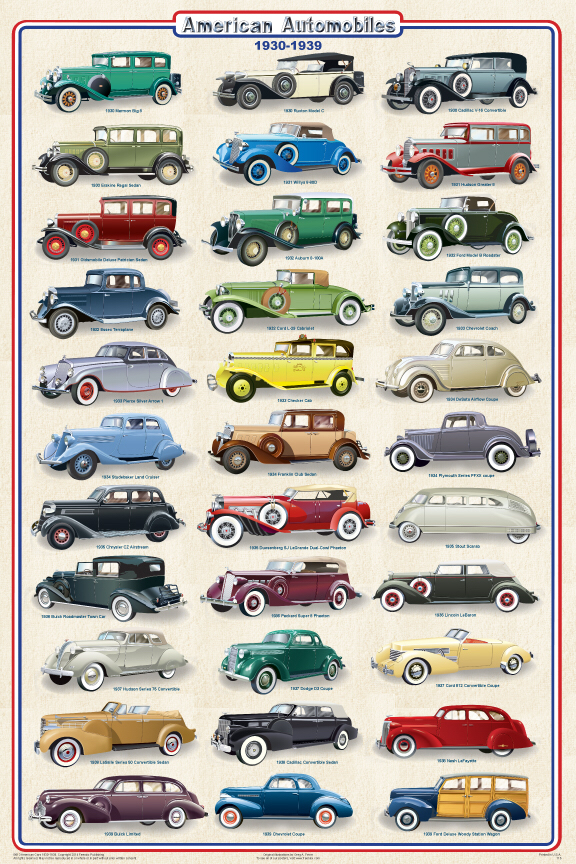
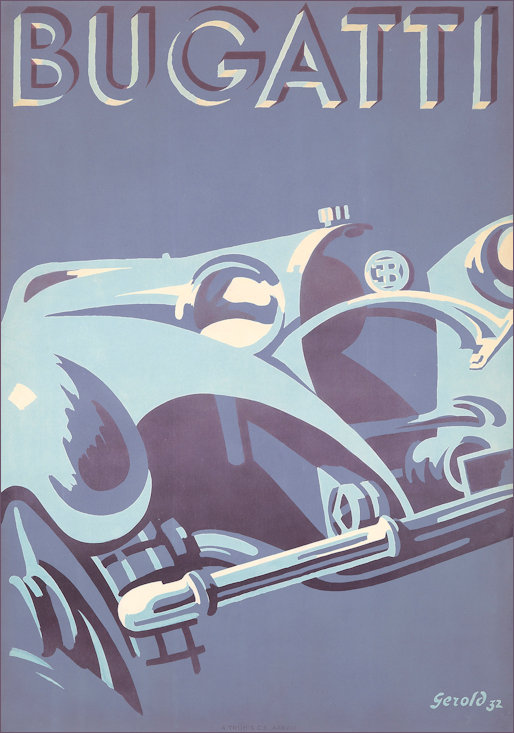
1932 Bugatti advert created by Swiss illustrator Gerold Hunziker 1894–1980
"A breathtaking deconstruction of a 1930s Bugatti in mid-pounce. No auto marque in the world has had such a consistent run producing vehicles of such staggering beauty, elegance, and sculptural form – and without a doubt Bugatti’s finest designs appeared between 1927 and 1938. Gerold’s interpretation here is a masterpiece of commercial art, concentrating on the car as a multitude of wavelike curves rushing headlong upon you." - image and dialogue sourced from rare_posters.tumblr

The art deco period—from the 1920s to the 1940s—is known for blending modern decorative arts with industrial design and is today synonymous with luxury and glamour.
The automobile, a rapidly evolving mechanical child of the 20th century, thus became the perfect metal canvas upon which to express the popular art deco style. While today manufacturers often strive for economy and efficiency, this was a period when innovation and elegance reigned supreme. Influenced by an international art movement, automakers embraced the sleek, new streamlined forms and aircraft-inspired materials to create memorable automobiles that still thrill all who see them. With bold, sensuous shapes; handcrafted details; and luxurious finishes, the 14 automobiles and three motorcycles in the exhibition provide stunning examples of car design … with artistic flair. Source : ncartmuseum.org
What is an Art Deco Car?
Art Deco was an artistic movement that dominated nearly every form of creative expression in the period between World War I and World War II. From the Chrysler Building to furniture to paintings and advertisements, Art Deco brought about a new era of style that combined extravagance with simplicity and functionality. That design language extended to automobiles as well, particularly the ultra-expensive cars from Europe in the 1930s. While much of the world suffered through the Great Depression, there remained a class of people untouched by a struggling economy and they demanded their automobiles -- still a relatively rare and expensive thing to own at the time -- have a level of opulence that reflected the spirit of the times. Source : howstuffworks
1930 - The Studebaker Fleet
Wow! What a way to enter and dominate the decade (although purists may argue that this is the end of the 1920s decade and the 1930s begin with 1931) or complete the decade - we have 'The Commander', 'The President', 'The Director' and even 'The Dictator' models!
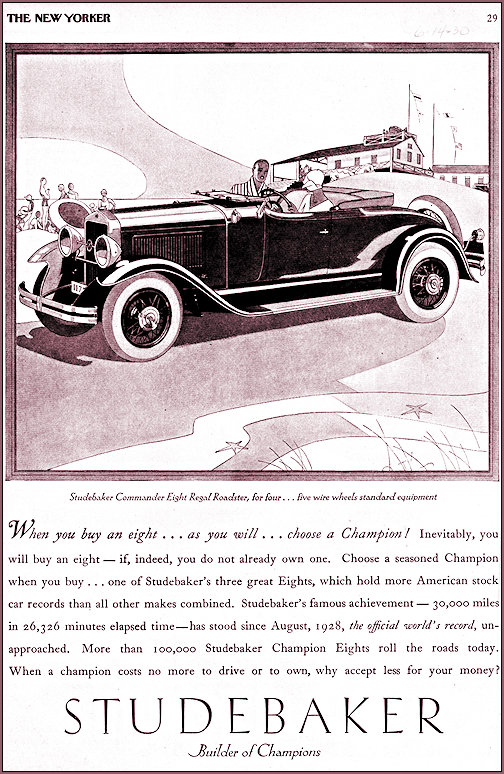
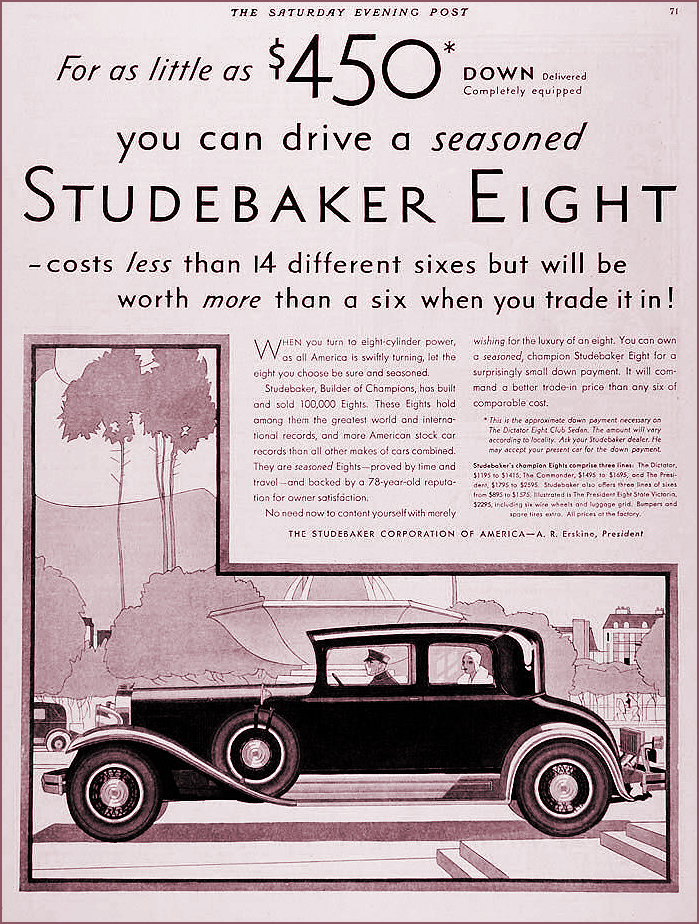
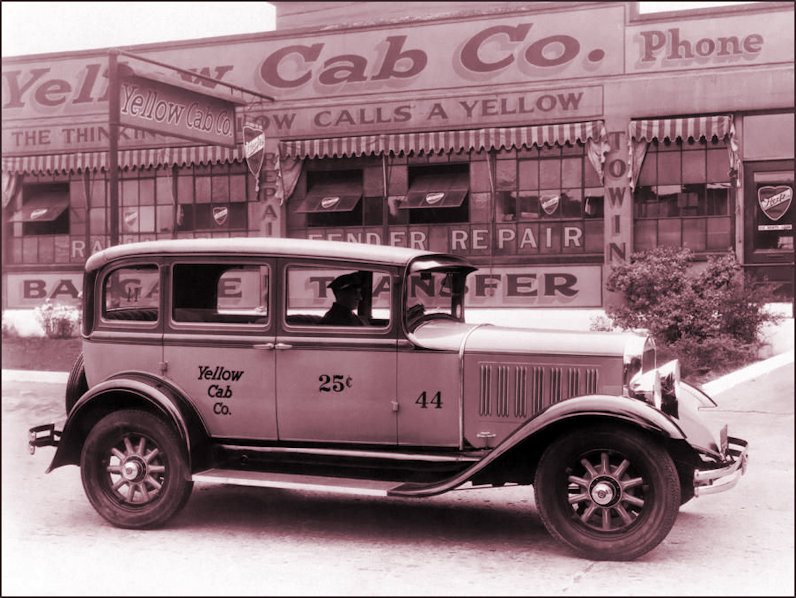
As this working car is 'The Dictator' I wanted to include it travel section of this decade.
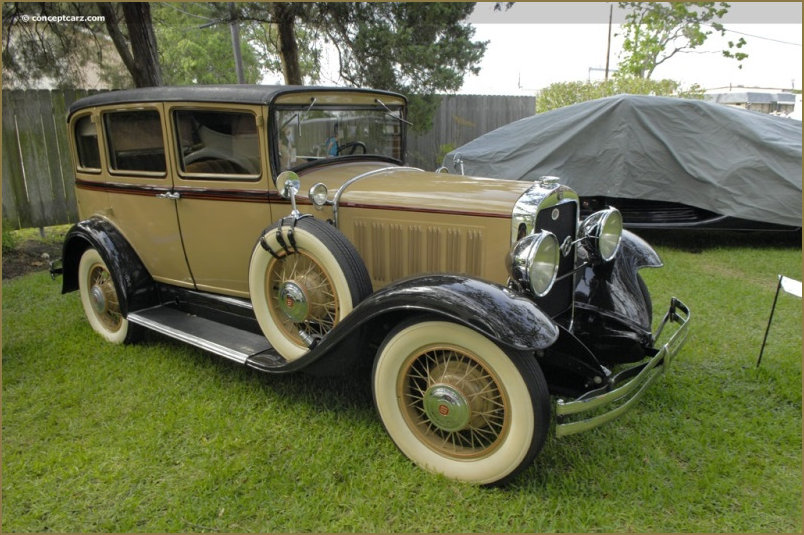
And when not working 'The Dictator' is described as a Regal Sedan - image courtesy & © of conceptcarz.com
1931 - Reo Royale
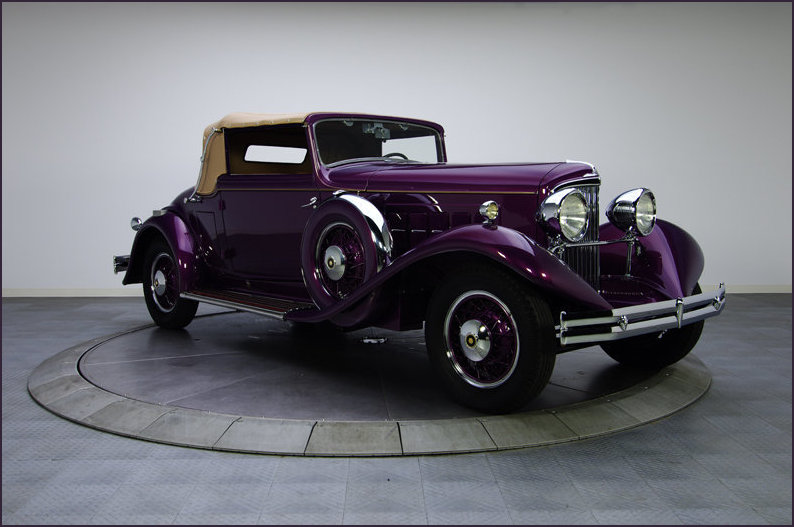
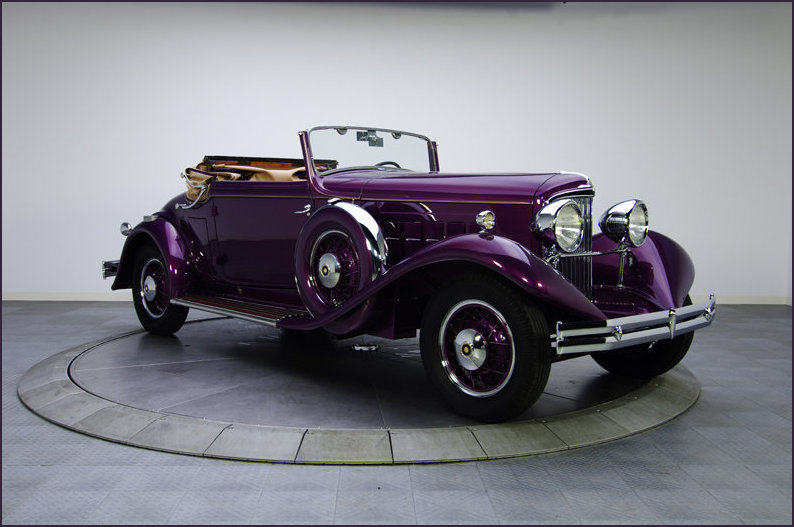

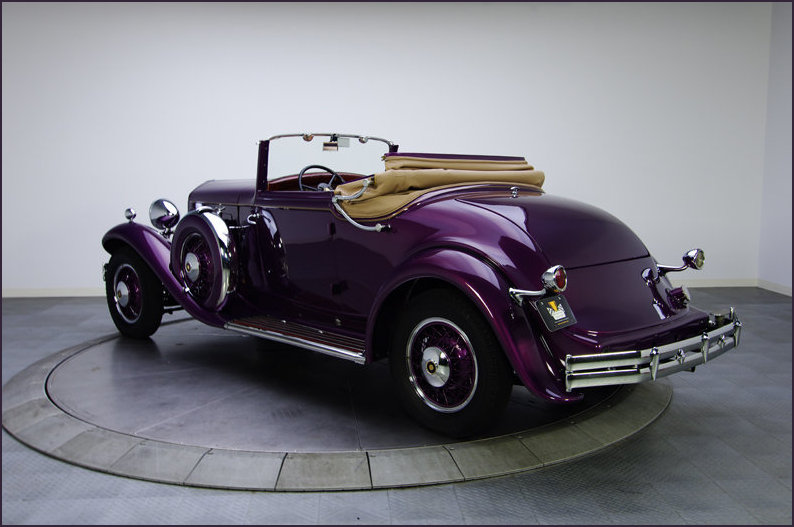
A complete restoration with original plum coloured bodywork ("as shown in the brochure") by RK Motors who also own the © of the images used

Image sourced from Car Style Critic whose excellent blog can be found here
Yes of course I chose this model as representative of 1931 because of the colour and because it's a fun car like a Classic Mini - it wants to be admired!
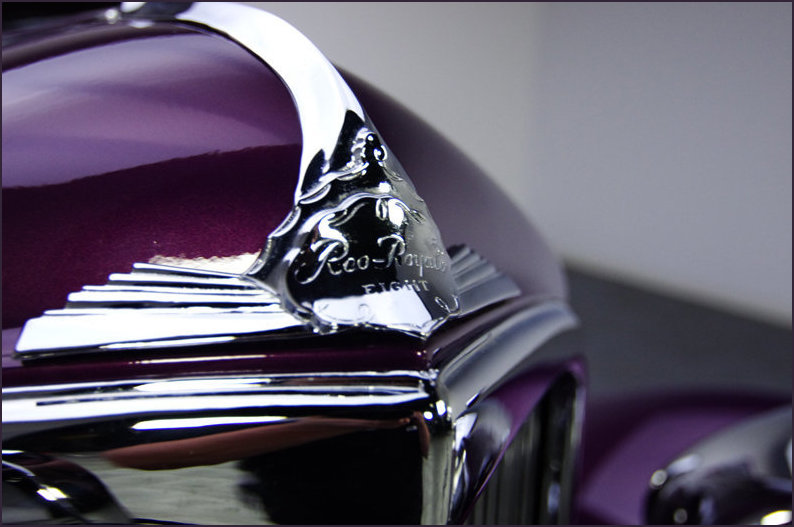
Image courtesy & © of RK Motors
RK Motors say this about the restoration "For those of you unfamiliar with the REO brand, it's a direct result of Ransom Eli Olds (hence REO) being ousted from the original company that bore his name, Oldsmobile. Always an innovator, Olds started anew with REO, determined to build cars (and trucks for that matter) to suit every budget. His crowning achievement, the Royale, was designed to compete with some of the biggest names in the luxury car business during the early 1930s, including Chrysler and Packard. Considered Full Classics by the Classic Car Club of America (CCCA), the Royale convertible coupe is perhaps the pinnacle of the brand's design and engineering prowess. With a unique combination of power and style, the Royale could almost be considered the muscle car of its era. This 1931 Reo Royale has been comprehensively restored by Reo Club of America historian, John Barker. The color is a deep plum, and before you dismiss it as a fad color from a dated older restoration, please note that it has been very recently restored to match the vehicle shown in original Royal literature of the era. Nowhere is the classic long hood/short deck styling more pronounced than on this Royale convertible coupe, whose proportions suggest great power and speed, and it's really not merely a suggestion. The short deck houses a rumble seat for two passengers, and it also features accessories like metal sidemount covers, a golf bag door, and dual tail lights. The restoration work was carried out to the absolute highest standards, and as a rare vehicle, such work can be incredibly challenging. The lights in our photo booth don't capture the depth and finish on the paint, but it is absolutely breathtaking, and this is a car that can be shown without concerns. This is a stunning motorcar." Read the full article here
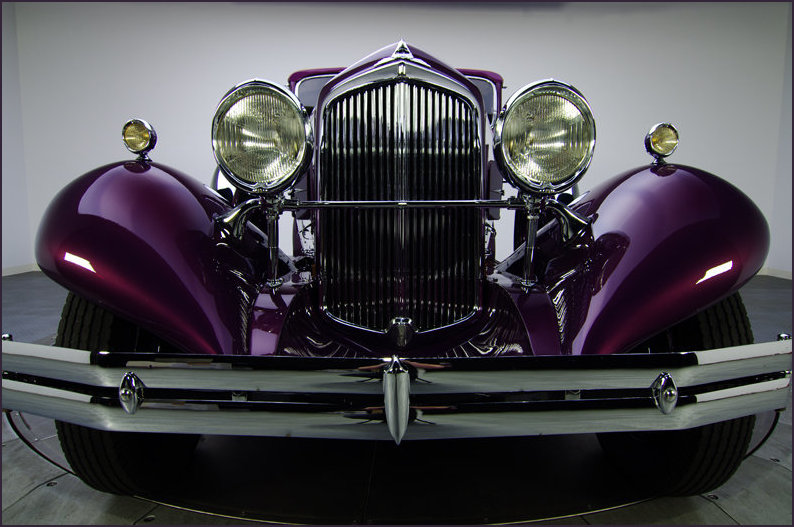
Image courtesy & © of RK Motors
From SignificantCars.com "The REO Motor Car Company was a Lansing, Michigan-based company that produced automobiles and trucks from 1905 to 1975. At one point the company also manufactured buses on its truck platforms. Ransom E. Olds was an entrepreneur who founded multiple companies in the automobile industry. In 1897 Olds founded the Olds Motor Vehicle Company (later, as Oldsmobile, to become a part of General Motors). In 1905 Olds left Oldsmobile and established a new company, REO Motor Car Company, in Lansing, Michigan. Olds had 52 percent of the stock and the titles of president and general manager. To ensure a reliable supply of parts, he organized a number of subsidiary firms like the National Coil Company, the Michigan Screw Company, and the Atlas Drop Forge Company. Originally the company was to be called "R. E. Olds Motor Car Company," but the owner of Olds' previous company, then called Olds Motor Works, objected and threatened legal action on the grounds of likely confusion of names by consumers. Olds then changed the name to his initials. Olds Motor Works soon adopted the popular name of its vehicles, Oldsmobile (which, along with Buick and Cadillac, became founding divisions of General Motors Corporation). The company's name was spelled alternately in all capitals REO or with only an initial capital as Reo, and the company's own literature was inconsistent in this regard, with early advertising using all capitals and later advertising using the "Reo" capitalization. The pronunciation, however, was as a single word. Lansing is home to the R. E. Olds Transportation Museum. The 1931 Reo Royale was a trendsetting design, introducing design elements that were a precedent for true automotive streamlining in the American market. The 8 cylinder model was sold through 1933 with minor updates. Beverly Kimes, editor of the Standard Catalog of American Cars, terms the Royale "the most fabulous Reo of all". In addition to its coachwork by Murray designed by their Amos Northup, the Royale also provided buyers with a 125 hp straight-eight with a nine bearing crankshaft, one shot lubrication, and thermostatically controlled radiator shutters. The Royale rode upon factory wheelbases of 131 (Model 8-31) and 135 inches (Model 8-35); a 1932 custom version rode upon a 152-inch wheelbase (Model 8-52). As many as 3 Dietrich coachbuilt bodies were built on 148 inch wheels base in 1931. Beginning in 1933, the Royale also featured as an option REO's semi-automatic transmission, the Self-Shifter. The Model 8-31 was priced at 2145.00 dollars. The model 8-35 was priced from 2745.00 dollars for the sedan to 3,000.00 dollars for the convertible coupe. The coachbuilt cars were priced close to 6,000 dollars. A convertible victoria was listed at 3195.00 dollars but only one is known to have been built. The 8-35 & 8-52 are considered full CCCA classics."
1932 - Marmon Sixteen Convertible Coupe by LeBaron & the Marmon 1932 Packard.
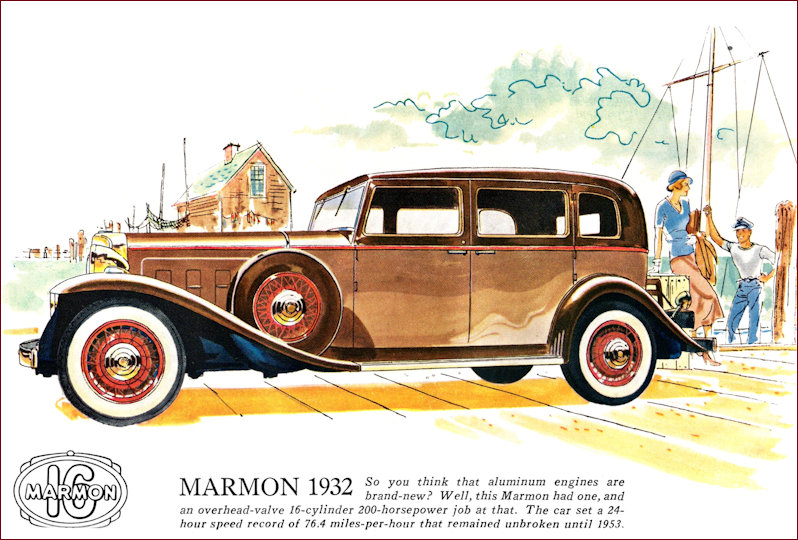
As advertised the Marmon Packard 1932 - image sourced from the imperialclub.com
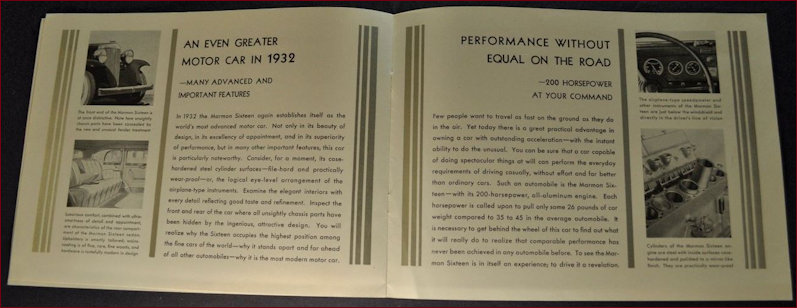
A copy of the manual for the Marmon 16 - as seen on ebay.com
Chosen by Sotheby's as "the car for 1932", in their 'The Cars that defined a Decade' series
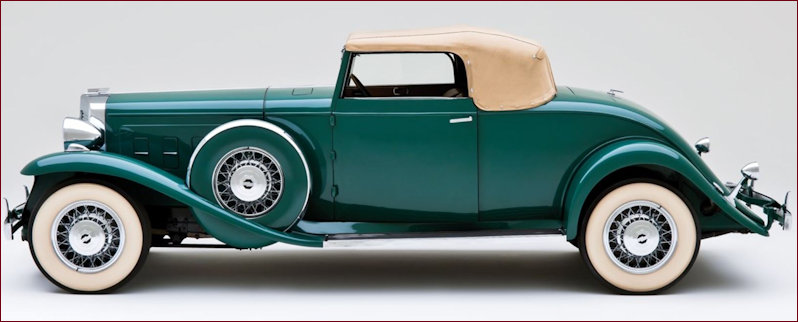
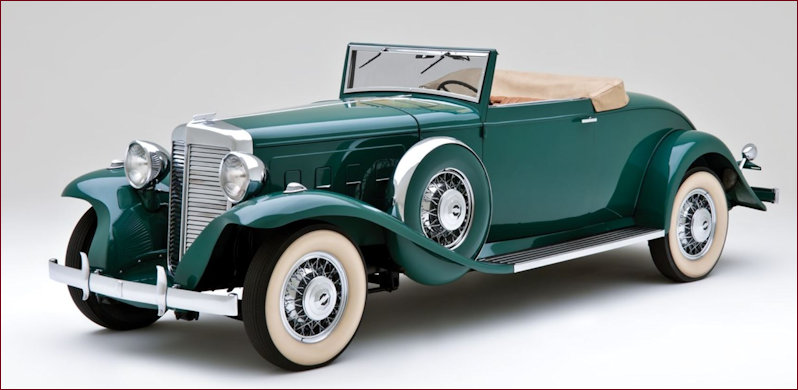
Images of the Marmon 16 sourced from Sotheby's
Like all great pieces of art, the Marmon Sixteen was one man’s vision of perfection. Automobile pioneer Colonel Howard Marmon created a triumph of pattern-making and foundry technology, containing at its heart an all-aluminum V-16 engine on a state-of-the-art chassis. With 200 horsepower from over 490 cubic inches, the car was capable of out-accelerating a Duesenberg Model J—yet it cost buyers only one-third as much. It was dressed by Walter Dorwin Teague, Jr., an MIT student working for his father’s industrial design firm, whose crisp lines devoid of gratuitous ornamentation and characterized by crisp design shapes embodied the lean sportiness of the age. It was a design in which superb styling and world-class engineering existed with harmonious balance, as has seldom been seen before or since. Like a fine Swiss watch or the best mahogany speedboat, it whispered quietly but firmly of its owner’s wealth and exquisite taste. Seventy-six remain in existence; only eight of them are convertible coupes, by far the most desirable style. Source : Sotheby's
1933 - Silver Arrow
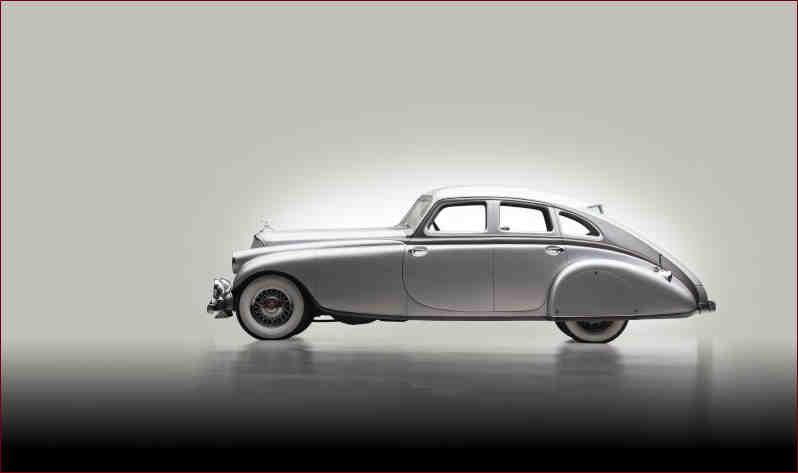
Image sourced from - PreWarCars
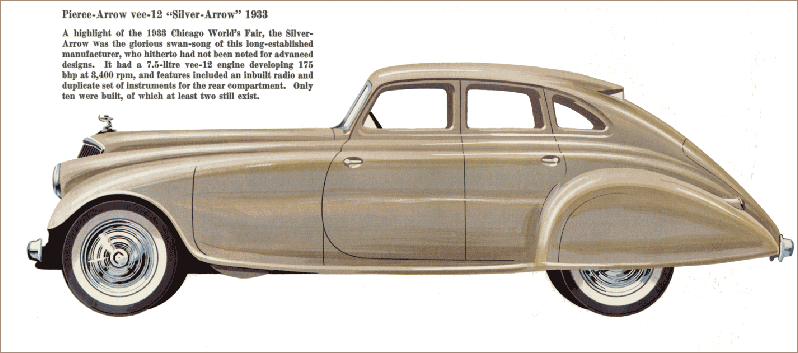
Image sourced from - SM Cars
1933 - Art Deco styling. Art Deco influenced the design of buildings, furniture, jewellery, fashion, movie theatres, trains, ocean liners, everyday objects such as radios and vacuum cleaners, and cars!! A more sleek form of the style, called Streamline Moderne, appeared in the 1930’s.
The Chicago World’s Fair presented one of the most intriguing and desirable pre-war cars, the 1933 Pierce-Arrow Silver Arrow concept car, the ultimate example of Streamline Moderne. With a design that was far ahead of its time, unexpectedly progressive for a brand like Pierce Arrow and introduced a year before other streamlined cars like the Chrysler Airflow and Tatra T77, it was the talk of the town. Sotheby’s describes it “the car that inaugurated the streamlined automotive age.” With its sleek design with integrated fenders, its innovative technique and its powerful V12 engine, it surpassed in attention other automobile masterpieces that were also introduced during the World’s Fair, like the one-off Duesenberg Model SJ Torpedo Sedan, Packard’s advanced V-12-powered Sport Sedan and Cadillac’s Aero-Dynamic Coupe with 16 cylinders.
Designer of the 1933 Pierce-Arrow Silver Arrow was Phillip O. Wright. In 1931, during a unwanted delay because his car had been stolen, he met in Chicago Roy Faulkner, who was at that time president of the Cord Corporation. Together they created the elegant Cord L-29 Speedster. When Roy Faulkner became Vice-President of Pierce-Arrow he asked Phil Wright to join him. Wright, aged 26, then designed the Silver Arrow, a car that was developed with Studebaker in South Bend, together with a streamlined car for Studebaker, the 1934 Land Cruiser, that was also presented during the Chicago World’s Fair. Source : PreWarCars :
Only five were built, of which three are still existing. Nr. 3 has been sold in December 2015 by RM Sotheby’s for $3,740,000. Read more here
1934 - Jean Harlow & her Cadillac
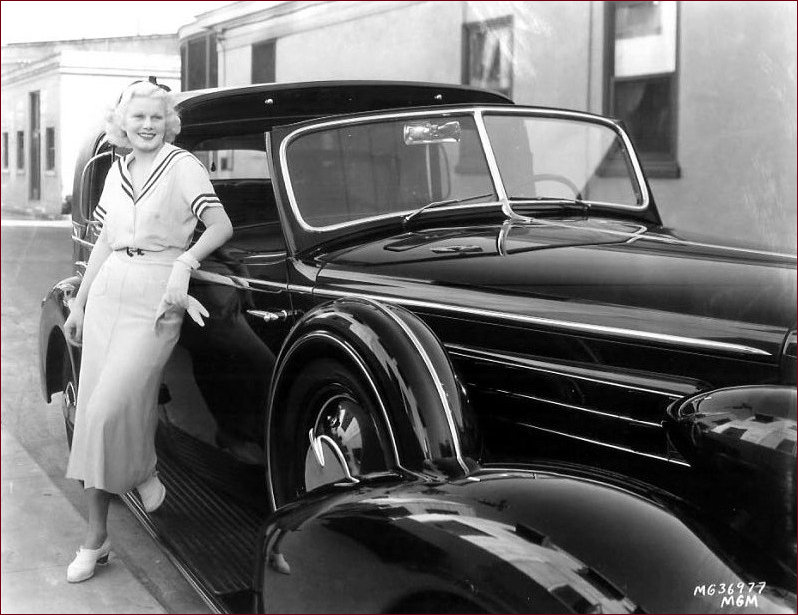
1935 - Hispano Suiza K6 Cabriolet
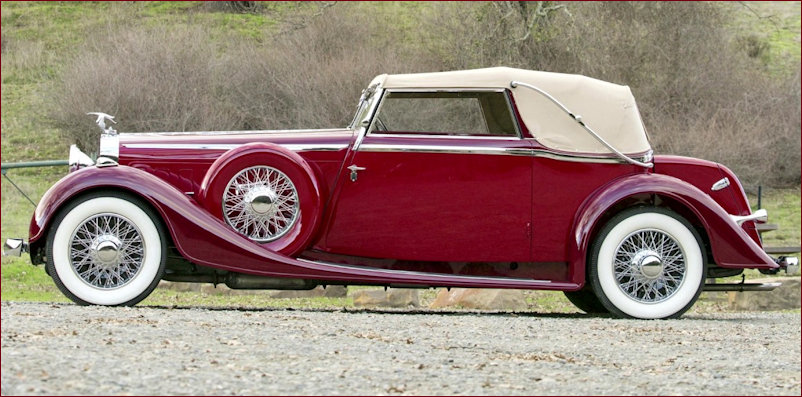
Is this the 'It Car' of 1935? - Image courtesy of Bonhams
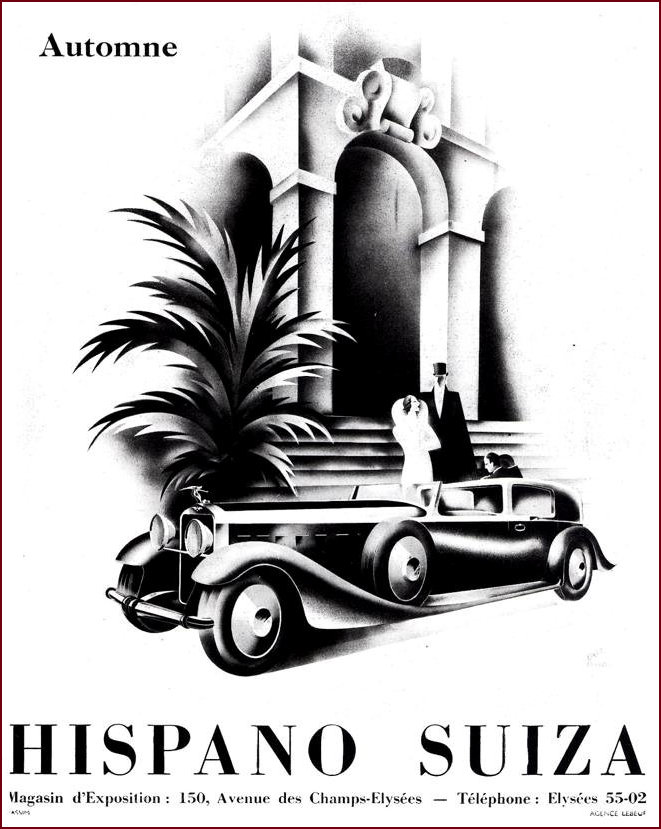
Designed for Autumnal travelling - the 1935 Hispano-Suiza Sedanca de Ville poster - image sourced from Pinterest
The choice of European Royalty, Indian Maharajahs, Hollywood film stars and industrial tycoons, the legendary Hispano-Suiza marque was superbly engineered and unashamedly imitated by some of the world's leading car manufacturers. The K6 model was the spiritual successor to the legendary H6, which had been the world's most advanced automobile at the time of its introduction in 1919 and for many years thereafter. The H6 was cataloged until 1933, by which time 2,158 chassis of all types had been completed.
In 1931, the smaller Ballot-based HS26 Junior was introduced, only to be superseded in 1934 by the lovely K6. The K6 shared many mechanical and chassis components with its otherworldly sibling, the incredible 9.5 liter twelve-cylinder Hispano-Suiza J12 model. In this way, the K6 Normal chassis rode on the same 342 cm wheelbase as the J12 Court, and the gearbox, brakes, steering and suspension were identical. Indeed, for historians, it has been a constant source of confusion over the years to tell a K6 from a J12 without a chassis number to aid identification.
The K6 was a superior long distance touring chassis for owners who did not desire the size and complexity of a J12, but wanted the same high quality, superior standard of excellence, beautiful road manners and unquestioned prestige of driving a Hispano-Suiza. K6 production is believed to have been a mere 204 chassis, all fitted with individually coach built bodies, painstakingly constructed by the very finest carrossiers in France and abroad. Source and to read more : Bonhams
1936 - Mercedes-Benz 540 K Special Cabriolet by Sindelfingen
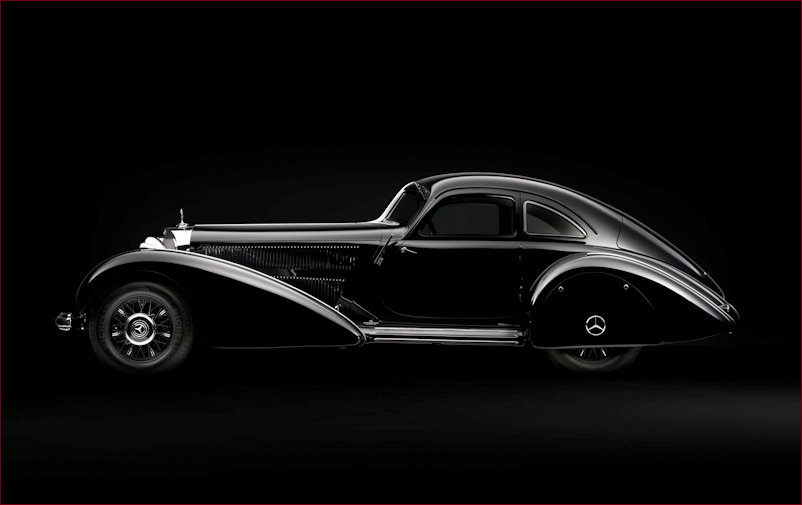
Image source : supercars.net
1936 Mercedes-Benz 540 K Special Cabriolet by Sindelfingen 5,401 cc overhead-valve inline eight-cylinder engine with accelerator-actuated Roots supercharger, twin-updraft pressurized carburetors, four-speed manual transmission, independent wishbone and coil-spring front suspension, independent swing-arm rear suspension with trailing arms, double coil springs, and lever-action shocks, and four-wheel hydraulic drum brakes. Wheelbase: 128 in. A fully unique commission from Sindelfingen Styling cues inspired by the Autobahnkurier. Built for American aristocrat William A.M. Burden Jr.
Well known, respected, and one of a kind The Burden family made its original fortune in horseshoes, reportedly shoeing the entire Union Army during the Civil War. For obvious reasons, the bottom eventually fell out of the horseshoe business, but William A.M. Burden Sr. and his brother, James, both preserved the family’s good standing by marrying Vanderbilts. Over the years, the Burden carriage house was home to an ever-changing range of the finest cars that money could buy. Bespoke commissions from all the great coach builders flowed through the family office for Bill Burden’s approval: pencil drawings of suggestions from Waterhouse, blueprints from Brewster for the latest Rolls-Royce, and original designs by Gordon Buehrig to tempt the prospective Duesenberg owner. Burden did, indeed, buy a Duesenberg, as well as a Hispano-Suiza J12 and a fully one-off, black-on-black Speedster that had been dreamed up with Harry Miller and combined front-wheel-drive and a Miller-built V-16. In 1936, planning on travels in Europe, Burden went to Mercedes-Benz for a 540 K, and as with his other cars, standard bodywork for the car was simply out of the question. Reportedly, his request was for a design influenced by the factory’s great racing cars of the era. By the time it evolved into metal, Sindelfingen’s commission, number 219611, had become the Special Cabriolet shown here. After being delivered to Paris in August 1936, the Burden 540 K in its final form bore little resemblance to the contemporary W125. Instead, the influence of the car’s owner and the Miller-Burden Speedster is apparent in the separate fenders, its lack of running boards, and the monochromatic black-on-black color scheme, as well as the blackwall tires and very little exposed bright metal trim. French design influences also crept in, with a wonderfully sloped and flared grille, which channels period Delahayes, and curvaceous fender lines drawn to a teardrop taper, which were nearly identical to those found on the famed Autobahnkurier Coupes. Even the usual 540 K hood louvers took on a gentle roundness. The car borrowed the idea of a spare inset and flush with the rear deck from the 540 K Special Roadster, keeping the wheel out of sight except from a direct rear view. Yet, with plans for “grand touring” in Bill Burden’s mind, provisions were made to mount a second wheel on top of the first, as is shown in some period photographs of the car. Burden’s European touring in the car was cut short by the advent of World War II, and when he returned to the United States, his 540 K came with him. Source : Robert Myrick Photography
1937 - Cadillac Fleetwood Series 70 Sport Coupe

Image source - connorsmotorcar.com
The 1937 Cadillac Series 70 rested on a 131 inch wheelbase, the same size as the 1936 model, along with the same body styles (Touring Sedan, Convertible Sedan, Sport Coupe, and Convertible Coupe). All the Series 70 bodies were Vee windshield examples by Fleetwood. They had a narrower radiator shield with the new louver-style 'Convex Vee' grill. The headlights were positioned on the radiator shell and the front fenders had a crease along the center line. The engine was an L-head, 346 cubic-inch unit offering 135 horsepower - the same as the 1936 model year. They had a three-speed selective gearbox with synchromesh and hydraulic brakes on four wheels. The bodies were the same as the prior year except they had drip molding located along the bottom of the front pillar and continued up and over the doors and the rear quarter windows. Most of the bodies featured a built-in trunk and the wheel disc were given a hub cap. For Cadillac, the Series 70 and 75 (combined) proved to be one of the more popular models for the company, generating 4,232 examples produced. The only model that saw higher production was the Series 60 with 7,003 units sold. Just 478 examples of the Series 85 were produced and just 50 examples of the Series 37-90 (sixteen cylinder) were sold. Source : conceptcarz.com
1937 - The Talbot Lago T-150C SS Goutte d'Eau

I wanted to add this car as it fascinated me and was my first choice for the 1937 slot when I found this image, believing it to be a Bugatti - as it happens thanks to drivemag it has been identified as a Talbot Lago T-150C SS Goutte d'Eau! Image courtesy & © of caradisiac.
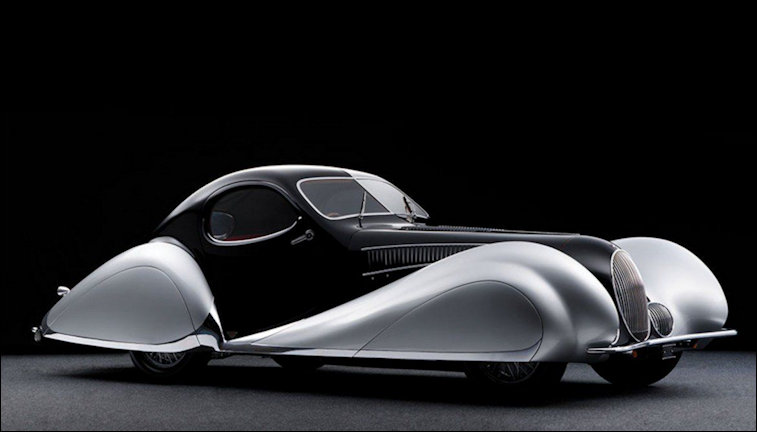
In its full splendour as shown in drivemag where it features, quite rightly, in the 'Most Beautiful Cars of the 20s and 30s' section
'Without a doubt one of the most beautiful cars ever made, the Talbot-Lago Teardrop Coupé was designed by Giuseppe Figoni, one of the greatest French coachbuilders before World War II. The sheer definition of Art-Deco, the T-150C SS was nicknamed Goutte d'Eau (teardrop) because of its round shape and sensual curves. Not just a pretty car, though, as the Talbots of the era won many races, including the French Grand Prix of 1937. A stock Talbot Teardrop even competed at the 1938 24 of Le Mans race, placing third overall.'
1938 - Delahaye 135 MS Pourtout
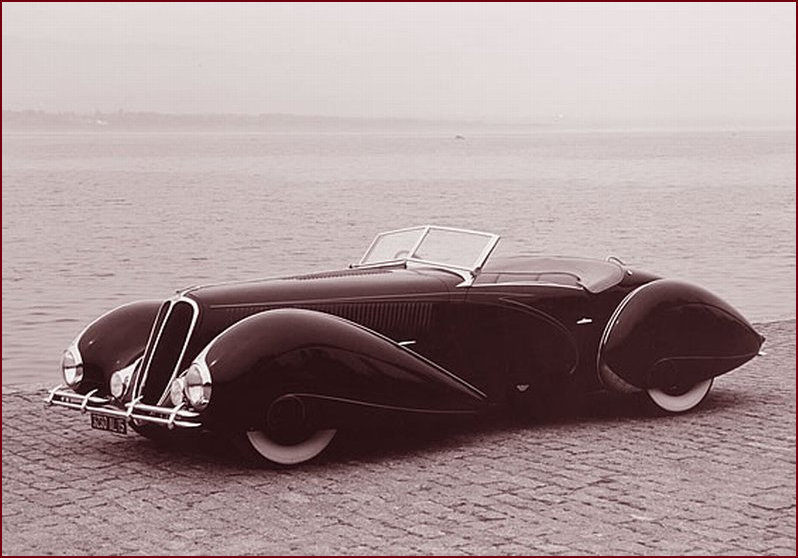
Image source : myntransportblog
The Delahaye 135 MS was launched in 1938 as a special high-end version (MS stands for Modifie Speciale) of the 135 from 1935. The 135 MS has a 125 horsepower, 3.5-liter, 6-cylinder engine and could reach a top speed of 100 mph. Many famous coachbuilders such as Saoutchik, Chapron, Letourneur et Marchand and Pourtout made beautiful bodywork for the 135 MS chassis.
This aerodynamic coupe by Carrosserie Pourtout was inspired by Georges Paulin's prewar designs. Paulin worked for Marcel Pourtout in his Carrosserie in Rueil-Malmaison in the suburbs of Paris, and had many special designs attributed to his name, including the 1938 Embiricos Bentley and the 1934 Peugeot Eclipse with a retractable steel cabriolet roof, a construction he patented. This Delahaye 135 MS Coupe is probably one of his last designs since, when Paris was occupied in 1940, Paulin joined the British Secret Service to fight the Nazi regime, but tragically was arrested and executed.
This aerodynamic Delahaye 135 MS coupe by Claude Pourtout was built for the Paris Auto Salon in 1946. The Salon was the first motor show after the war and this Delahaye was the feature car on the Pourtout stand. It was inspired by the works of Georges Paulin who had worked with Claude Pourtout at his Carrosserie in Paris before the war and had designed many wonderful cars including the 1938 Embiricos Bentley and the 1934 Peugeot 'Eclipse' with a retractable steel cabriolet roof, a construction which he patented.
Emile Delahaye was born in Tours, France in 1843. He studied engineering in Angers, France. In 1869 he began work with his engineering degree in applied arts and crafts. Source : conceptcarz
1939 - Ford de-Luxe (Fordor) v-8 Range
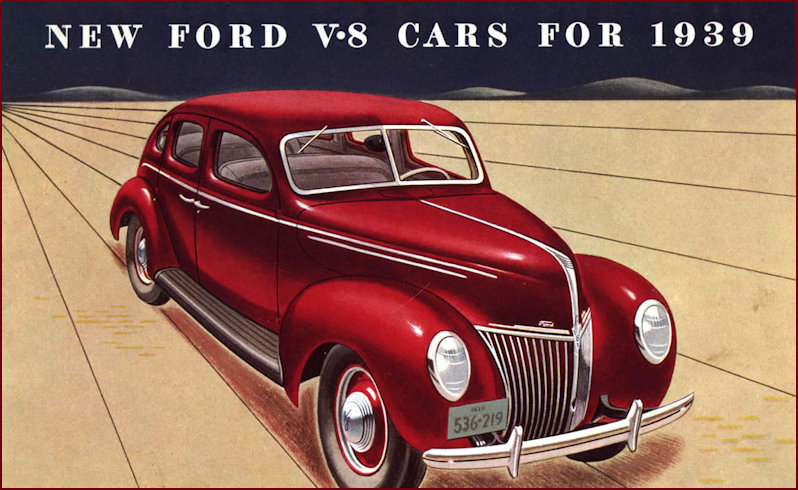
Ford announces its 1939 de-luxe range - image courtesy of oldcarbrochures.com
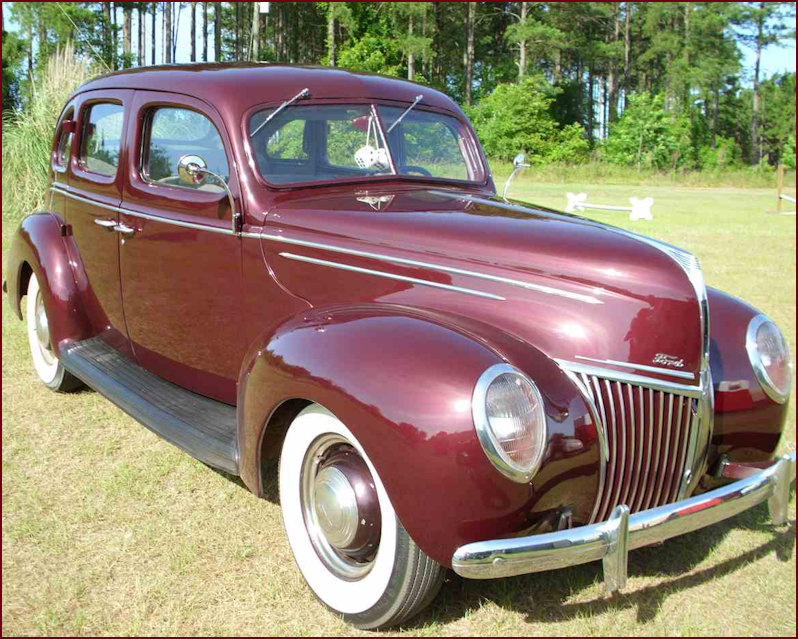
An actual example (still running today by the looks of it) of the deluxe 'Fordor' - image sourced from americanclassiccars.com
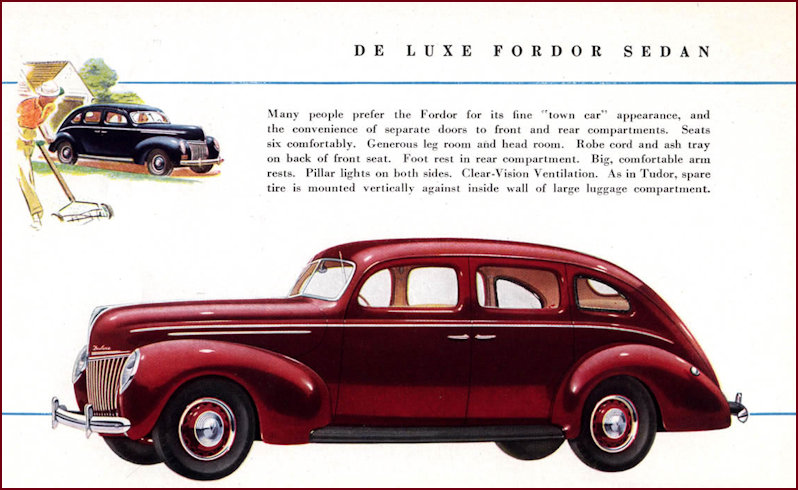
The brochure gives an overview of the 'town car' and its fine appearance - image courtesy of oldcarbrochures.com
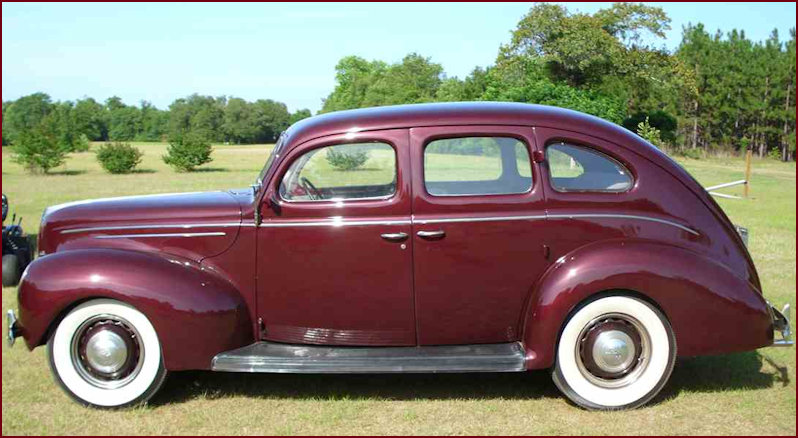
Another example of the durability of this Ford Classic - image sourced (and flipped to match illustration) from classiccars.com
Public / Commercial Goods & Services

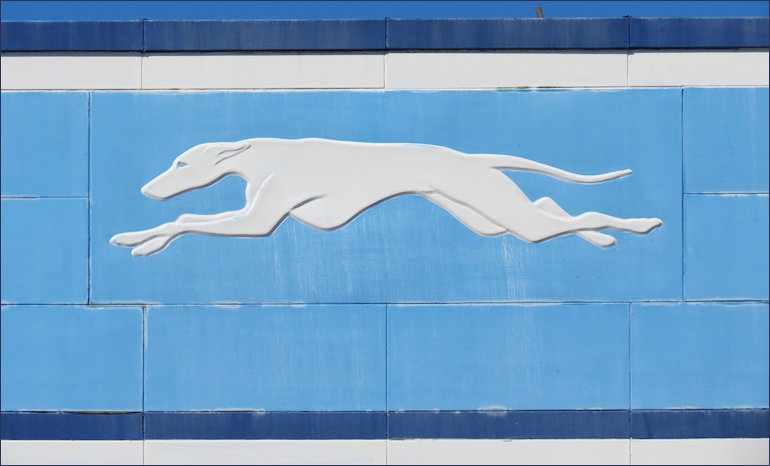

If you didn't have a car there was always public transport in the form of the Greyhound Bus Service - top images courtesy & © of louisvilleartdeco.com post restoration, greyhound logo ceramic feature and a contemporary postcard advertising the bus station.
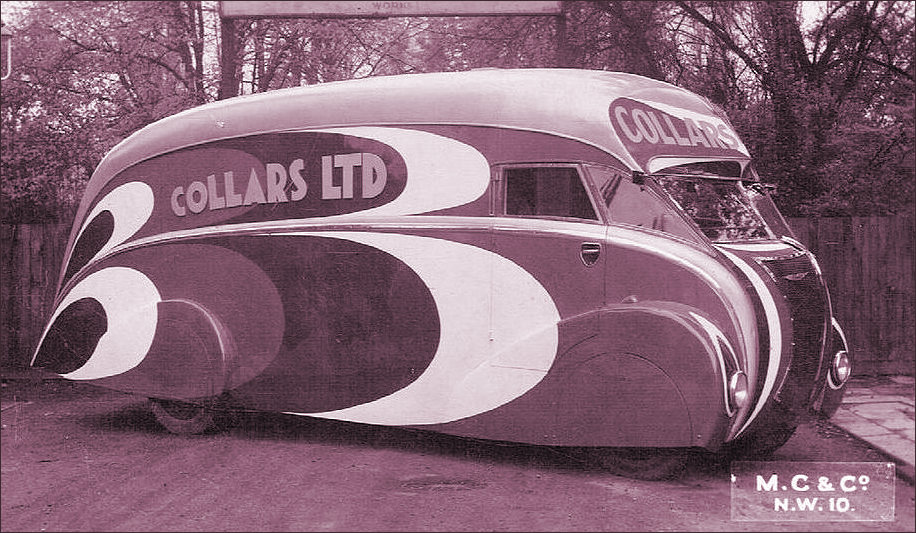
Or why not have your goods delivered in a stylish streamline moderne van? - Image (and plenty more to look at) sourced from Pinterest
Hood / Bonnet Ornaments
The Silver Arrow Archer

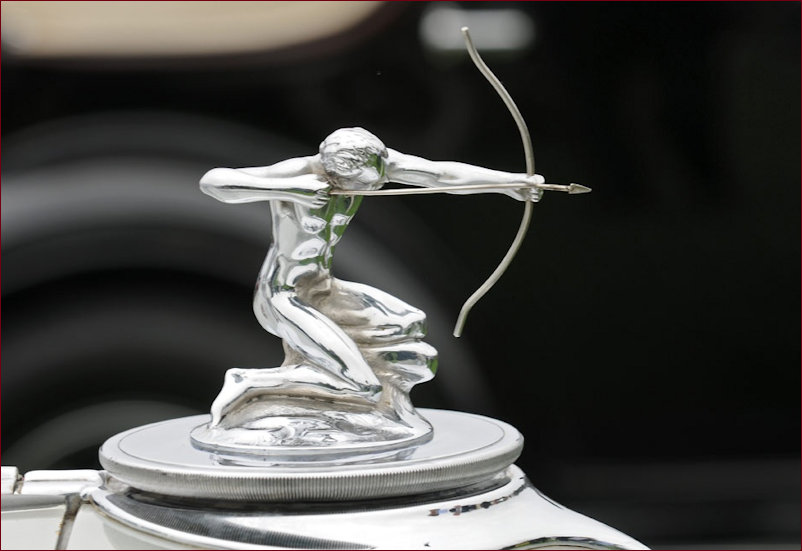
With thanks to Concept Cars for the image of the Archer
& Having Fun
Girls in a Boot

1926 - Vogue Fashion
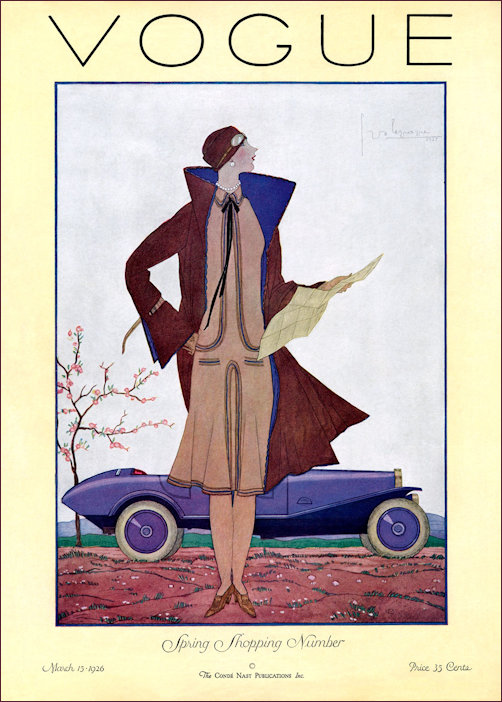
1926 Geneva Motor Show
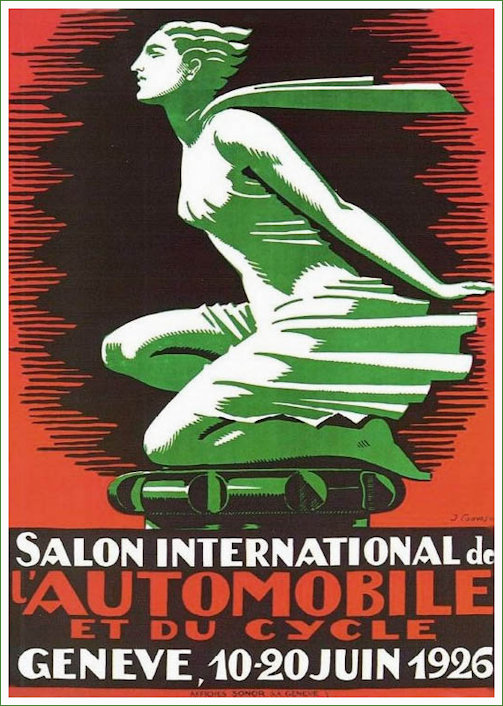
1932 Beach Belle on a Motor Cycle
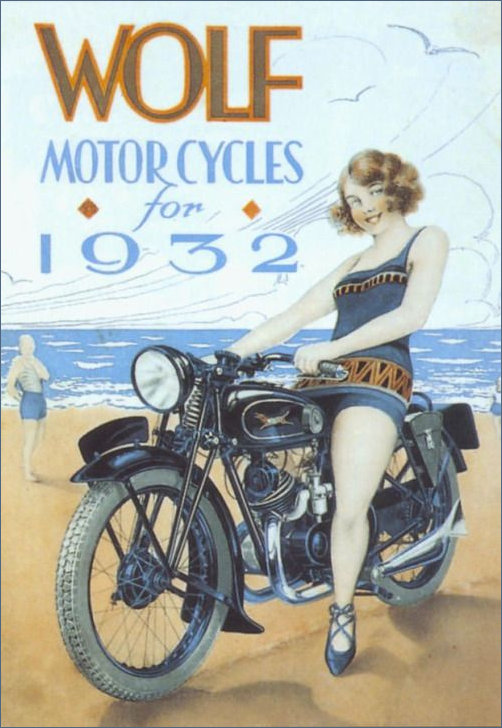
Walking the Dog - The Distinguished Hupmobile 8
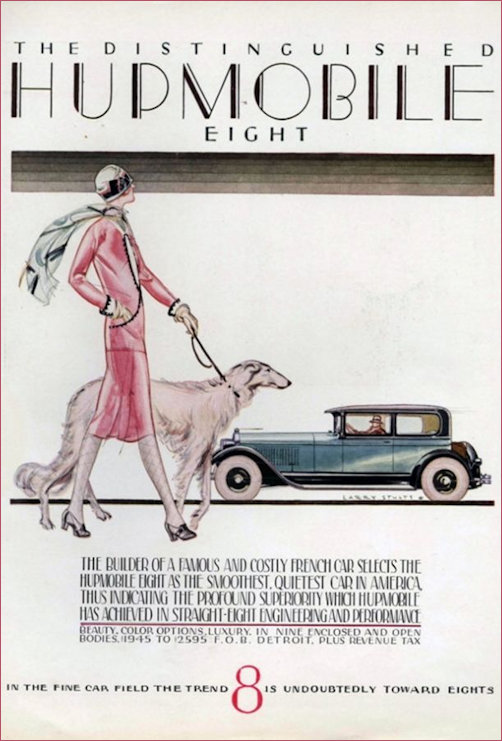
Page refreshed : 24th June 2020 (G)